Navigon PREMIUM 70 LIVE, PREMIUM 70, PLUS 70 User Manual
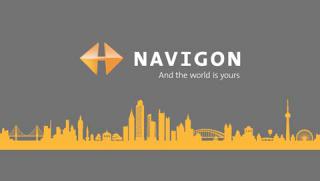
User’s manual
NAVIGON Plus 70/71 NAVIGON Premium 70/71 NAVIGON Premium 70/71 LIVE
English (United Kingdom)
April 2010

The crossed-out wheeled bin means that within the European Union the product must be taken to separate collection at the product end-of- life. This applies to your device but also to any enhancements marked with this symbol. Do not dispose of these products as unsorted municipal waste.
Imprint
NAVIGON AG Schottmüllerstraße 20A
D-20251 Hamburg
The information contained herein may be changed at any time without prior notification. Neither this manual nor any parts thereof may be reproduced for any purpose whatsoever without the express written consent of NAVIGON AG, nor may they be transmitted in any form either electronically or mechanically, including photocopying and recording. All technical specifications, drawings etc. are subject to copyright law.
2010, NAVIGON AG All rights reserved.

User’s manual NAVIGON Plus 70/71 | Premium 70/71 | Premium 70/71 LIVE
Table of contents
1 |
Introduction |
....................................................................................... |
8 |
|
|
1.1 |
About this manual ................................................................................... |
8 |
|
|
|
1.1.1 .............................................................................. |
Conventions |
8 |
|
|
1.1.2 .................................................................................... |
Symbols |
8 |
|
1.2 |
Legal notice............................................................................................. |
8 |
|
|
|
1.2.1 ...................................................................................... |
Liability |
8 |
|
|
1.2.2 .............................................................................. |
Trade marks |
9 |
|
1.3 |
Questions ...................................................................about the product |
9 |
|
2 |
Before you begin............................................................................... |
9 |
||
|
2.1 |
Scope of ....................................................................................Delivery |
9 |
|
|
2.2 |
Description .....................................................of the navigation device |
10 |
|
|
2.3 |
Important ..................................................................safety information |
10 |
|
|
|
2.3.1 .................................................. |
Navigation safety information |
10 |
|
|
2.3.2 ...........................Safety information for the navigation device |
11 |
|
|
|
2.3.3 .........Safety guidelines when installing the device in your car |
11 |
|
|
2.4 |
Preparing ...............................................the navigation system for use |
12 |
|
|
|
2.4.1 .................................................................................. |
SIM card |
12 |
|
|
2.4.2 ........................Installing the navigation system in the vehicle |
13 |
|
|
|
2.4.3 ........................................................................... |
Memory card |
15 |
|
2.5 |
Activating .................................................the NAVIGON Live services |
15 |
|
|
2.6 |
Navigating .............................................................................with GPS |
16 |
|
3 |
Switching on ..............................................the navigation device |
17 |
||
|
3.1 |
Manual .................................................................................................. |
|
19 |
|
3.2 |
Options.................................................................................................. |
|
19 |
4 |
Operating the ..................................................navigation system |
19 |
||
|
4.1 |
Information ............................................................................................ |
19 |
|
|
4.2 |
Software ................................................................................keyboard |
23 |
|
|
|
4.2.1 ............................................................................ |
Special keys |
23 |
|
|
4.2.2 ........................................................................... |
Entering data |
24 |
|
4.3 |
Options.................................................................................................. |
|
25 |
|
4.4 |
Menus ................................................................................................... |
|
25 |
5 |
Voice Command.............................................................................. |
25 |
||
|
5.1 |
Activating ...............................................the voice commands function |
26 |
|
|
5.2 |
Use Voice ............................................................................Command |
26 |
|
|
5.3 |
Help....................................................................................................... |
|
27 |
User’s manual |
Table of contents III |

User’s manual NAVIGON Plus 70/71 | Premium 70/71 | Premium 70/71 LIVE
|
5.4 |
Deactivation of the voice commands function....................................... |
27 |
|
|
5.5 |
Configuring the voice commands function ............................................ |
27 |
|
6 |
Navigation |
....................................................................................... |
28 |
|
|
6.1 |
Starting the navigation application ........................................................ |
28 |
|
|
6.2 |
Specifying a destination ........................................................................ |
30 |
|
|
|
6.2.1 ..... |
Specifying the country in which the destination is situated |
30 |
|
|
6.2.2 ............................ |
Entering a destination by voice commands |
30 |
|
|
6.2.3 ............................................... |
Entering a destination address |
32 |
|
|
6.2.4 ................................................................... |
Enter Coordinates |
33 |
|
|
6.2.5 ..................................................................... |
Points of interest |
34 |
|
|
6.2.6 ............................................ |
Information about the destination |
38 |
|
|
6.2.7 ............................................................................... |
Favourites |
39 |
|
|
6.2.8 .................................................................... |
Last Destinations |
40 |
|
|
6.2.9 .................................. |
Imported Addresses: Outlook / Internet |
40 |
|
|
6.2.10 .............................. |
Imported Addresses from the phone book |
41 |
|
|
6.2.11 ..................................................................... |
Navigating home |
41 |
|
|
6.2.12 .......................................... |
Selecting destinations on the map |
42 |
|
|
6.2.13 ......................................................................... |
Route preview |
43 |
|
6.3 |
Managing ..........................................................................destinations |
44 |
|
|
|
6.3.1 ................................................................. |
Saving destinations |
45 |
|
|
6.3.2 ..................................................... |
Defining the home address |
45 |
|
6.4 |
Tracks ...................................................................and multi-leg routes |
46 |
|
|
|
6.4.1 ....................................................... |
Entering the starting point |
46 |
|
|
6.4.2 ............................................................... |
Entering route points |
47 |
|
|
6.4.3 ................................................................. |
Editing route points |
47 |
|
|
6.4.4 ..................................................................... |
Managing routes |
48 |
|
|
6.4.5 ......................................................... |
Loading routes or tracks |
48 |
|
|
6.4.6 ........................................... |
Calculating and displaying routes |
49 |
|
|
6.4.7 .................................................................... |
Simulating routes |
49 |
|
|
6.4.8 ......................................................................... |
Route preview |
50 |
7 |
Options ............................................................................................ |
|
51 |
|
8 |
Working with .....................................................................the map |
54 |
||
|
8.1 |
Selecting ................................................................the navigation map |
54 |
|
|
8.2 |
Button ..............................................................................................bar |
54 |
|
|
|
8.2.1 ...................................................................... |
Static button bar |
54 |
|
|
8.2.2 ................................................................. |
Dynamic button bar |
55 |
|
8.3 |
Proximity ....................................................................................sensor |
57 |
|
|
|
8.3.1 ............................................ |
Configuring the proximity sensor |
57 |
|
8.4 |
Map in ..........................................................................Standard mode |
58 |
|
|
8.5 |
Map in ............................................................................Preview mode |
59 |
|
IV Table of contents |
User’s manual |

User’s manual NAVIGON Plus 70/71 | Premium 70/71 | Premium 70/71 LIVE
8.6 |
Map in Navigation mode ....................................................................... |
60 |
|
|
8.6.1 Navigation in Vehicle mode .................................................... |
60 |
|
|
8.6.2 Navigation in Pedestrian mode ............................................... |
65 |
|
|
8.6.3 Navigation in Track mode ....................................................... |
66 |
|
|
8.6.4 Navigation in Offroad mode .................................................... |
67 |
|
|
8.6.5 Map options in Navigation mode............................................. |
67 |
|
|
8.6.6 |
Quitting navigation .................................................................. |
68 |
8.7 |
Map in Destination search mode........................................................... |
68 |
|
|
8.7.1 Operating in Destination search mode.................................... |
69 |
|
9 Useful functions.............................................................................. |
70 |
||
9.1 |
Route profiles ........................................................................................ |
70 |
|
|
9.1.1 |
Route profile settings .............................................................. |
70 |
|
9.1.2 |
NAVIGON basic profiles ......................................................... |
70 |
|
9.1.3 Creating a new route profile.................................................... |
71 |
|
|
9.1.4 Selecting a route profile .......................................................... |
71 |
|
|
9.1.5 |
Managing route profiles .......................................................... |
72 |
9.2 |
MyPOIs |
................................................................................................. |
73 |
9.2.1Memory location for your own POIs and your own
|
|
symbols ................................................................................... |
73 |
|
9.2.2 |
Creating your own destinations ............................................... |
74 |
|
9.2.3 |
Symbols for your own POIs .................................................... |
75 |
9.3 |
Screenshots .......................................................................................... |
75 |
|
|
9.3.1 |
Enabling screenshots .............................................................. |
75 |
|
9.3.2 |
Creating a screenshot ............................................................. |
75 |
9.4 |
Tracks |
................................................................................................... |
76 |
9.5 |
Parking .................................................................near the destination |
77 |
|
9.6 |
Nearby................................................................................................... |
|
78 |
9.7 |
POI on ................................................................................Your Route |
79 |
|
|
9.7.1 ............................................. |
Displaying POIs along the route |
79 |
|
9.7.2 ...................................... |
Navigating to one of the destinations |
80 |
|
9.7.3 ................................................................ |
Selecting categories |
81 |
9.8 |
NAVIGON ..........................................................................Sightseeing |
81 |
|
9.9 |
Sightseeing .................................................................................Tours |
83 |
|
9.10 |
Direct Help ............................................................................................ |
84 |
|
9.11 |
GPS Status, ...............................................saving the current location |
85 |
|
9.12 |
Block ..................................................................................................... |
|
85 |
9.13 |
Turn-by ...................................................................................-Turn List |
86 |
|
User’s manual |
Table of contents V |

User’s manual NAVIGON Plus 70/71 | Premium 70/71 | Premium 70/71 LIVE
|
9.14 |
TMC (Traffic Information) ...................................................................... |
87 |
|
|
|
9.14.1 |
Preview TMC........................................................................... |
87 |
|
|
9.14.2 |
Displaying traffic information................................................... |
89 |
|
|
9.14.3 Showing a single message in detail........................................ |
90 |
|
|
|
9.14.4 |
TMC Settings .......................................................................... |
91 |
|
9.15 |
Logbook |
................................................................................................ |
91 |
10 |
Handsfree Module........................................................................... |
92 |
||
|
10.1 |
Connection with Mobile Phone.............................................................. |
94 |
|
|
|
10.1.1 Searching for and pairing Bluetooth devices .......................... |
95 |
|
|
|
10.1.2 Pairing from the mobile phone ................................................ |
96 |
|
|
|
10.1.3 Connecting to a device ........................................................... |
97 |
|
|
|
10.1.4 Activating a mobile phone....................................................... |
98 |
|
|
|
10.1.5 |
Deleting a device .................................................................... |
99 |
|
|
10.1.6 |
Import Phone Book ................................................................. |
99 |
|
|
10.1.7 |
Import recent calls................................................................. |
100 |
|
10.2 |
Taking a call ........................................................................................ |
101 |
|
|
10.3 |
Receiving a text message................................................................... |
101 |
|
|
10.4 |
Making a call ....................................................................................... |
102 |
|
|
|
10.4.1 Making a call with the voice commands function .................. |
102 |
|
|
|
10.4.2 Dialling a telephone number ................................................. |
103 |
|
|
|
10.4.3 Dialling a Speed Call number ............................................... |
103 |
|
|
|
10.4.4 Calling a contact from the phone book ................................. |
103 |
|
|
|
10.4.5 Calling most recently dialled, received or missed |
|
|
|
|
|
numbers ................................................................................ |
104 |
|
|
10.4.6 Transferring a call from your mobile telephone..................... |
104 |
|
|
10.5 |
During a call ........................................................................................ |
104 |
|
|
|
10.5.1 Moving the navigation application to the foreground ............ |
104 |
|
|
|
10.5.2 |
Entering numbers.................................................................. |
105 |
|
|
10.5.3 |
Muting the microphone ......................................................... |
105 |
|
|
10.5.4 Transferring a call to the mobile phone................................. |
105 |
|
|
|
10.5.5 |
Ending the call ...................................................................... |
105 |
|
10.6 |
Useful functions................................................................................... |
105 |
|
|
|
10.6.1 Navigating to a contact from the phone book ....................... |
105 |
|
|
|
10.6.2 |
Opening the mailbox ............................................................. |
106 |
|
10.7 |
Configuring the hands-free function.................................................... |
106 |
|
|
|
10.7.1 |
Preset.................................................................................... |
106 |
|
|
10.7.2 |
Settings ................................................................................. |
107 |
11 |
Navigon Live.................................................................................. |
108 |
||
|
11.1 |
Before you begin ................................................................................. |
108 |
|
|
|
11.1.1 |
Costs..................................................................................... |
109 |
VI Table of contents |
User’s manual |

User’s manual NAVIGON Plus 70/71 | Premium 70/71 | Premium 70/71 LIVE
|
11.2 |
Using the NAVIGON Live services...................................................... |
109 |
|
|
|
11.2.1 |
Weather Service ................................................................... |
109 |
|
|
11.2.2 |
Parking.................................................................................. |
111 |
|
|
11.2.3 |
Google Local Search ............................................................ |
111 |
|
|
11.2.4 |
Traffic Information ................................................................. |
113 |
|
11.3 |
Configuring the NAVIGON Live services ............................................ |
113 |
|
|
11.4 |
Indicating the status ............................................................................ |
114 |
|
12 |
Configuring the navigation system ............................................. |
115 |
||
13 |
Appendix ....................................................................................... |
|
116 |
|
|
13.1 |
Technical data of the navigation device.............................................. |
116 |
|
|
13.2 |
NAVIGON Licensing Policy................................................................. |
117 |
|
|
13.3 |
Declaration of Conformity.................................................................... |
121 |
|
14 |
Troubleshooting............................................................................ |
121 |
||
15 |
Index .............................................................................................. |
|
125 |
|
User’s manual |
Table of contents VII |

User’s manual NAVIGON Plus 70/71 | Premium 70/71 | Premium 70/71 LIVE
1 Introduction
1.1About this manual
1.1.1Conventions
For better legibility and clarification, the following styles are used in this manual:
Bold and italics: |
Names of products |
SMALL CAPITALS: |
Names of windows and dialogue boxes |
Bold: |
Highlighting of important parts in the text |
Underlined: |
Descriptions of buttons, input boxes and other |
|
elements on the user interface |
Underlined and italics: |
Names of control elements on the navigation |
|
device |
1.1.2Symbols
The following symbols refer to specific passages of text:
 Instructions and tips for operating the software
Instructions and tips for operating the software
 More detailed information and explanations
More detailed information and explanations
 Warnings
Warnings
1.2Legal notice
1.2.1Liability
The software and manual are subject to change without notice. NAVIGON AG is not liable for the accuracy of the information contained in this manual or for damages resulting from the use of this manual.
Suggestions for improvements and information regarding errors are always welcome so that we can supply you with even better products in the future.
- 8 - |
Introduction |

User’s manual NAVIGON Plus 70/71 | Premium 70/71 | Premium 70/71 LIVE
1.2.2Trade marks
All brand and trade marks mentioned in this document and registered by third parties are subject without reservation to copyright law and the proprietary rights of their respective owners. All trade marks, trade names and company names used in this document are or may be trade marks or registered trademarks of their respective owners. All rights reserved except those explicitly granted.
If the registered trade marks used in this manual are not explicitly identified as such, this does not imply that the name is not subject to the rights of a third party.
►Microsoft, Outlook, Excel and Windows are registered trade marks of the Microsoft Corporation.
►NAVIGON is a registered trade mark of NAVIGON AG.
1.3Questions about the product
You have a question concerning your product? Then visit our website www.navigon.com and click on "Customer services". There you will find an area with frequently asked questions (FAQ Center) along with details of how to contact us by phone or e-mail.
2 Before you begin
2.1Scope of Delivery
Please check that the contents are complete. If anything is missing, get in touch immediately with the dealer who sold you the product.
The purchased product includes the following:
►Navigation device
►Designer car cradle
►Car charger cable (10-24V adapter for the vehicle's cigarette lighter) with integrated TMC antenna
►USB cable
►Leaflet with illustrated installation instructions
►Only NAVIGON Premium 70/71 LIVE:
►SIM card holder. The card holder is glued in the leaflet and can be removed easily. The SIM card has been broken out of its holder already.
►SIM card (is already inserted in the navigation device)
Note: Keep the SIM card holder in a safe place! You will need the data printed on this holder if you ever have to contact the NAVIGON Service Centre for assistance.
Before you begin |
- 9 - |
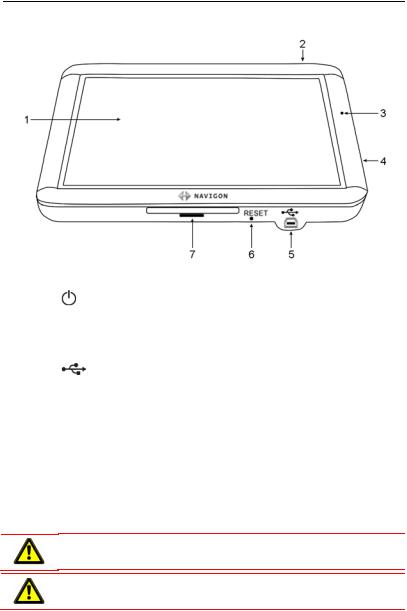
User’s manual NAVIGON Plus 70/71 | Premium 70/71 | Premium 70/71 LIVE
2.2Description of the navigation device
1 |
Touch-screen |
2 |
On/Off |
3Microphone
4 Slot for microSD memory card
Slot for microSD memory card
5 |
Mini USB socket for USB cable / mains adapter |
6 Reset
Reset
7LED
2.3Important safety information
In your own interest, please read the following safety information and warnings carefully before starting up your navigation system.
2.3.1Navigation safety information
Use the navigation system at your own risk.
Caution! To prevent accidents, do not operate the navigation system while driving.
Caution! Do not look at the screen unless it is absolutely safe to do so!
- 10 - |
Before you begin |

User’s manual NAVIGON Plus 70/71 | Premium 70/71 | Premium 70/71 LIVE
Caution! Traffic regulations have priority over any instructions from the navigation system.
Caution! Follow the instructions of the navigation system only when the circumstances and the road traffic regulations allow you to do so! The navigation system will still guide you to your destination even if you deviate from the calculated route.
Caution! Check that the cradle is secured and adjusted properly before each journey.
2.3.2Safety information for the navigation device
Caution! Protect the device from moisture. The device is neither waterproof nor protected against splash water.
Caution! Do not open the case of the navigation device under any circumstances.
Caution! Do not expose the navigation device to extreme heat or cold. This may damage the device or impair its function. (Refer to "Technical data" on page 116.)
Caution! Never unplug by pulling the cable. Doing so could severely damage or destroy the device.
Caution! Do not subject the navigation device to severe temperature fluctuations. This can cause condensation to form.
Note: Do not kink the cable. Make sure that the cable cannot be damaged by sharp-edged objects.
Note: Create a backup of the data in the internal memory of your navigation device.
This is very easy to do with the NAVIGON Fresh software which can be downloaded free of charge from our website www.navigon.com/fresh.
2.3.3Safety guidelines when installing the device in your car
Caution! Fasten the cradle so that the navigation device is easy to see and operate by the driver. Make sure that the driver's view of the traffic is not impeded.
Before you begin |
- 11 - |
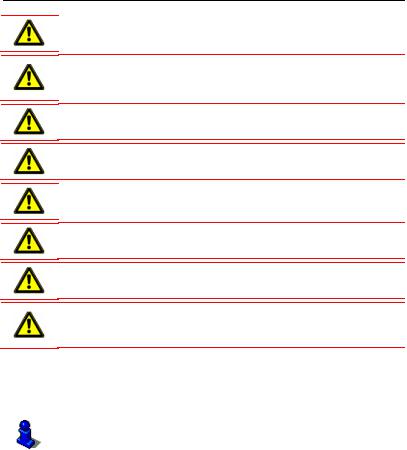
User’s manual NAVIGON Plus 70/71 | Premium 70/71 | Premium 70/71 LIVE
Caution! Do not attach the cradle within the working zone of any airbags.
Caution! Do not fasten the cradle too close to the steering wheel or other controls. The driver must not be obstructed in operating any car functions.
Caution! When installing the cradle, make sure that it will not pose a risk in the event of an accident.
Caution! Do not run cables directly next to safety-relevant devices and power supplies.
Caution! Check that the cradle is secured and adjusted properly before each journey. The suction cup may become loose after a while.
Caution! After installation, check all safety-relevant equipment in the car.
Caution! Connect the car charger cable only to cigarette lighters with an operating voltage of 10-24V.
Caution! Disconnect the car charger cable from the cigarette lighter whenever you park the car. The integrated mains adapter always consumes a small amount of energy and could drain the car battery.
2.4Preparing the navigation system for use
2.4.1SIM card
This chapter is relevant for you only if your navigation device is a
NAVIGON Premium 70/71 LIVE.
- 12 - |
Before you begin |
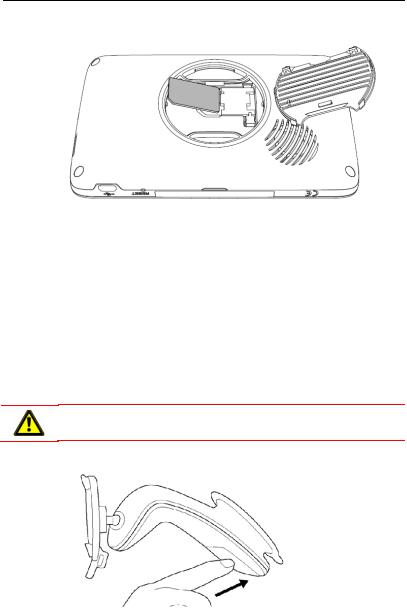
User’s manual NAVIGON Plus 70/71 | Premium 70/71 | Premium 70/71 LIVE
The SIM card is inserted at the back under the cover in the middle of the device.
1.Switch off the navigation device.
2.Insert a finger-nail in the recess on the top of the cover.
3.Pull the cover off the device.
4.Break the SIM card out of the SIM card holder. The card holder is glued in the leaflet and can be removed easily.
5.Insert the SIM card as shown in the illustration.
6.Replace the cover.
7.Push the cover firmly against the device until it latches home in all corners.
The procedure for removing the SIM card is similar to that just described.
2.4.2Installing the navigation system in the vehicle
Caution! Be sure to refer to all the safety information in chapter "Important safety information" on page 10.
Securing the cradle
Before you begin |
- 13 - |
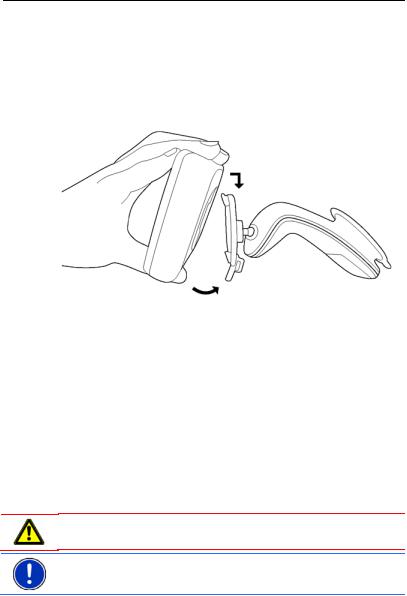
User’s manual NAVIGON Plus 70/71 | Premium 70/71 | Premium 70/71 LIVE
1.Clean the suction cup and that part of the windscreen to which you want to secure the cradle. Both must be dry and free of dirt and grease.
2.Open the lever on the suction cup as far as possible.
3.Place the cradle suction cup against the windscreen.
4.Press the lever towards the windscreen.
Inserting the navigation device into the cradle
On the back of the navigation device you will see a circle with two recesses.
1.Hang the navigation device by the upper recess on the upper lug of the cradle. (See illustration)
2.Then press it towards the cradle so that it latches in place.
Supplying power to the navigation device
Included in delivery of the navigation device is a car charger cable with which power can be supplied to the navigation device via the vehicle's cigarette lighter.
►Connect the car charger cable to the vehicle's cigarette lighter and to the mini USB socket of the navigation device.
The LED on the bottom of the navigation device lights up orange during charging.
As soon as the battery is fully charged, the LED lights up green.
Caution! Connect the car charger cable only to cigarette lighters with an operating voltage of 10-24V.
Note: Insert the USB connector securely in the corresponding USB sockets!
- 14 - |
Before you begin |
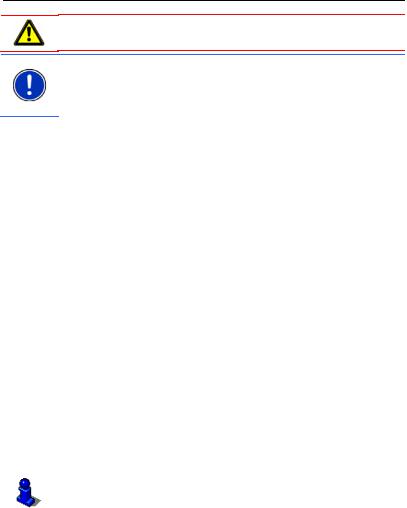
User’s manual NAVIGON Plus 70/71 | Premium 70/71 | Premium 70/71 LIVE
Caution! Be sure to refer to all the safety information in chapter "Important safety information" on page 10.
Note: It takes approx. 3 hours to charge the device when the battery is flat.
A fully charged battery enables up to 3 hours of use depending on the device configuration.
TMC antenna
The navigation device has an integrated TMC receiver. The TMC antenna is integrated in the car charger cable. Once the car charger cable is connected, the device can receive current traffic messages. If required, it can change your route dynamically, e.g. in order to avoid a traffic jam.
2.4.3Memory card
A memory card is not required to operate the navigation system because all the data required for navigation are stored in the internal memory of the device.
When you connect the navigation system to your computer using a USB cable, the internal memory is detected as the 'NAVIGON' drive. The slot for the memory card is detected as the 'NAVIGON SD' drive.
Data backups, software updates and navigation map updates can be carried out quickly and conveniently with the NAVIGON Fresh software, which you can download free of charge from the website www.navigon.com/fresh.
If you purchase additional navigation maps but no longer have enough space for them in the internal memory of your navigation device, it is also possible for you to save these maps on a memory card which you then insert in the device. The navigation system can use navigation maps from both memories.
2.5Activating the NAVIGON Live services
This chapter is relevant for you only if your navigation device is a
NAVIGON Premium 70/71 LIVE.
The NAVIGON Live services must be activated before they are used for the first time. Then they can be used free of charge for 3 months. (Refer to "Costs" on page 109.)
You have inserted the SIM card.
The leaflet with the activation code which came with the NAVIGON Live module is to hand.
1. Switch on the navigation device.
Before you begin |
- 15 - |

User’s manual NAVIGON Plus 70/71 | Premium 70/71 | Premium 70/71 LIVE
The NAVIGATION window opens.
2.Tap on  (NAVIGON Live).
(NAVIGON Live).
You will be asked whether you want to activate the NAVIGON Live services.
3.Tap on Yes.
4.Enter the activation code.
5.Tap on Activate.
The NAVIGON Live services are now activated.
6.Tap on OK.
The following message appears: "You are sending 'Floating Car Data' to NAVIGON in anonymised form. The evaluation of these data will help in calculating times of arrival more precisely, in recognising traffic congestion sooner, and in planning alternative routes more reliably. No information about your person can be derived from the data. If you do not agree, select 'No' for the setting 'Optimise'."
7.Tap on OK.
The NAVIGATION window is opened. From here you have access to all the functions of your navigation device and all available NAVIGON Live services.
2.6Navigating with GPS
GPS is based on a total of at least 24 satellites orbiting the Earth and continuously transmitting signals of their position and time. The GPS receiver receives this data and calculates its own geographical position on the basis of the information transmitted by the various satellites.
Data from at least three satellites is required for positioning with an acceptable degree of accuracy. With data from four or more satellites it is possible in addition to determine the position's altitude above sea level. Positioning is accurate to within three metres.
Once the navigation device has determined your position, this position can be used as a starting point for calculating a route.
The map data on your navigation device includes the geographical coordinates of all digitally recorded points of interest, streets and places. This enables the device to calculate a route between a starting point and a destination.
Calculation of the current position and its representation on the map take place approximately once every second. In other words, your current position is always shown on the map.
- 16 - |
Before you begin |
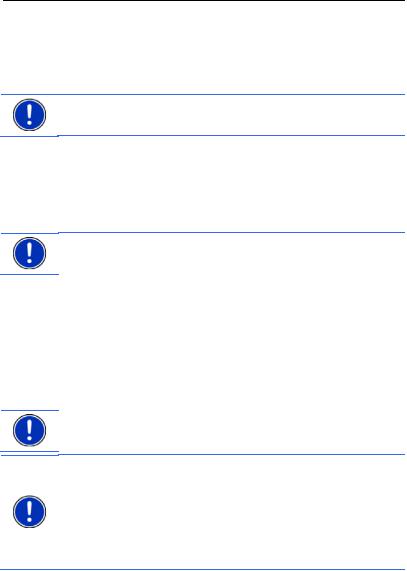
User’s manual NAVIGON Plus 70/71 | Premium 70/71 | Premium 70/71 LIVE
3 Switching on the navigation device
►Press the  (On/Off) key and keep it pressed until the device switches on.
(On/Off) key and keep it pressed until the device switches on.
The NAVIGATION window opens.
Note: The screen lights up briefly in white, indicating that you have started the device.
When you switch on the navigation system for the first time, you will be asked to make the following settings:
►your preferred language for using for the software
►the unit of length for distances
►the time format
►the date format
Note: When you start the navigation application for the first time, the DEMO MODE settings window opens.
Demo mode is intended only for demonstrating the product when no GPS reception is possible.
When demo mode is active, navigation is not possible! Demo mode is designed solely to simulate navigation to the centre of the indicated destination.
►Make sure that the Start in Demo Mode setting is at No. If
necessary tap on the  (Toggle) button in order to change the setting from Yes to No.
(Toggle) button in order to change the setting from Yes to No.
►Tap on OK.
Note: How to deactivate demo mode is explained in "Troubleshooting" in section "I have accidentally activated demo mode" on page 122.
Note: If you have not used the navigation device for a long time, the battery may be flat.
When you connect the navigation device to the supplied car charger cable, it can be switched on immediately even if the battery is flat. If you use a different charger cable or have connected your device to a PC, it may need charging for a few minutes before it can be switched on.
Chargers and other accessories are available in the NAVIGON online shop at www.navigon.com or in specialist stores.
Switching on the navigation device |
- 17 - |

User’s manual NAVIGON Plus 70/71 | Premium 70/71 | Premium 70/71 LIVE
Switching the navigation device to standby mode
►Press briefly on the  (On/Off) key (max. 1 second).
(On/Off) key (max. 1 second).
A message will appear telling you that the device will be switched to standby mode in several seconds.
►Wait for the device to be switched to standby mode or tap on Standby.
Automatic Standby
You can configure the navigation device so that it is automatically switched to standby mode when not in use.
►In the NAVIGATION window tap on Options > Settings > General > Automatic Standby.
►Select after how much time you want the navigation device to be switched to standby mode (Never, After 10 mins., After 20 mins., After 30 mins.).
►Select Power Loss in order to switch the device to standby mode when the external power supply is interrupted. As soon as the device is connected again to the external power supply it will switch on again automatically.
Switching off the navigation device
►Press the  (On/Off) key and keep it pressed until the device switches off (approx. 5 seconds)
(On/Off) key and keep it pressed until the device switches off (approx. 5 seconds)
-or-
1.Press briefly on the  (On/Off) key (max. 1 second).
(On/Off) key (max. 1 second).
A message will appear telling you that the device will be switched to standby mode in several seconds.
2.Tap on Off.
Note: When you switch the navigation device to standby mode, the next time it is switched on it will start very quickly and with the window which was active when switched off. In standby mode the device still consumes a small amount of energy however. Depending on how full the battery is, it can become flat within a few days or a few weeks.
When you switch off the device, it consumes no energy. It can then take several months for the battery to become flat. Switching the device on again triggers a restart which can take some time (approx. 30 seconds). Your settings and your saved destinations and routes will be retained.
- 18 - |
Switching on the navigation device |

User’s manual NAVIGON Plus 70/71 | Premium 70/71 | Premium 70/71 LIVE
3.1Manual
An excerpt of this manual describing the most important functions of the navigation software is saved on the navigation device.
To open the manual:
1.In the NAVIGATION window, tap on Options > Manual. The TABLE OF CONTENTS window opens.
2.Tap on the name of the chapter you want to read. The content of the chapter is shown.
With the  (Up) and
(Up) and  (Down) buttons you can scroll up one page and down one page respectively.
(Down) buttons you can scroll up one page and down one page respectively.
With the  (To the Left) and
(To the Left) and  (To the Right) buttons you can open the previous or the next chapter respectively.
(To the Right) buttons you can open the previous or the next chapter respectively.
►Tap on the Table of Contents button in order to open the Table of Contents window.
►Tap on the  (Close) button in order to close the manual. The NAVIGATION window is opened.
(Close) button in order to close the manual. The NAVIGATION window is opened.
3.2Options
Some windows offer options that lead to more functions.
A description of all available options can be found in the chapter "Options" on page 51.
4 Operating the navigation system
4.1Information
Various information symbols are located at the top of many windows.
GPS
The GPS symbol can indicate the following GPS reception states:
No GPS (No symbol): The built-in GPS receiver is not operational. Contact us if the problem persists. (Refer to "Questions about the product" on page 9.)
No Signal: Data is being received from less than three satellites. Position cannot be calculated.
Operating the navigation system |
- 19 - |

User’s manual NAVIGON Plus 70/71 | Premium 70/71 | Premium 70/71 LIVE
GPS Ready: Data is being received from at least 3 satellites. Position can be calculated.
For details of the GPS status refer to chapter "GPS Status, saving the current location" on page 85.
Compass
The Compass symbol indicates in which direction you are currently heading. It can indicate the following points of the compass: N, NE, E, SE, S, SW, W, NW.
Track
The  (Record Track) symbol indicates that a track is being recorded at this moment.
(Record Track) symbol indicates that a track is being recorded at this moment.
For more information about tracks refer to chapter "Tracks" on page 76.
Energy
The Energy symbol can indicate the following states of the integrated battery:
The device is being supplied by an external power source. The battery is fully charged.
The battery cannot be charged because its temperature is too high or too low.
The device is being supplied by an external power source. The battery is being charged.
The device is being supplied by its internal battery. The battery charge is sufficient.
The device is being supplied by its internal battery. The battery charge is low.
NAVIGON Live Services
This section is relevant for you only if your navigation device is a
NAVIGON Premium 70/71 LIVE.
- 20 - |
Operating the navigation system |
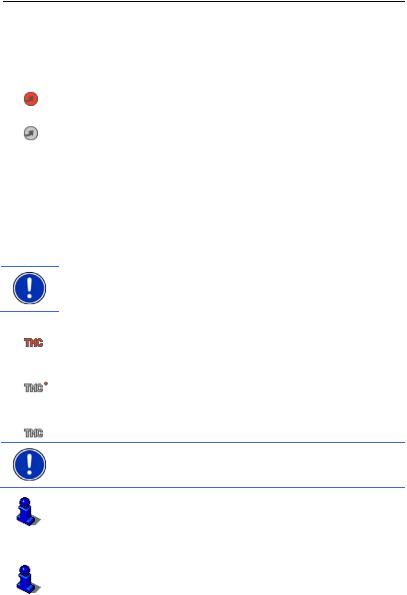
User’s manual NAVIGON Plus 70/71 | Premium 70/71 | Premium 70/71 LIVE
The NAVIGON Live Services symbol indicates the availability of the NAVIGON Live services. The following states can be symbolised:
(No symbol) No NAVIGON Live Services: The SIM card is not inserted or is wrongly inserted, or the NAVIGON Live services are deactivated. (Refer to "Configuring the NAVIGON Live services" on page 113.)
(Red) Connecting: The NAVIGON Live services are activated. There is no connection yet to the NAVIGON Live server.
(Light grey) NAVIGON Live Services Ready: There is a connection to the NAVIGON Live server. The NAVIGON Live services are available.
Traffic Information
TMC
The navigation system has an integrated TMC receiver which supplies up-to-date traffic information. Using this information the navigation system can change your route dynamically, for example in order to avoid a traffic jam.
Note: This function is only available if TMC traffic messages are being transmitted in the country in which you are travelling. This is not the case in all countries.
The TMC symbol can display the following TMC reception status:
Tuning (in red): The TMC receiver is operational but cannot find a transmitter that is sending TCM signals. There are no active traffic messages.
Tuning: The TMC receiver is operational but cannot find a station that is transmitting TMC signals. Traffic messages are active however. This can be the case, for example, when travelling through a tunnel.
TMC on Standby (in grey): Traffic messages can be received.
Note: The TMC antenna is integrated in the car charger cable. The Tuning symbol may still appear therefore when the car charger cable is not connected to the navigation device.
For details of the TMC function refer to chapter "TMC (Traffic Information)" on page 87.
Traffic Live
This section is relevant for you only if your navigation device is a
NAVIGON Premium 70/71 LIVE.
Operating the navigation system |
- 21 - |
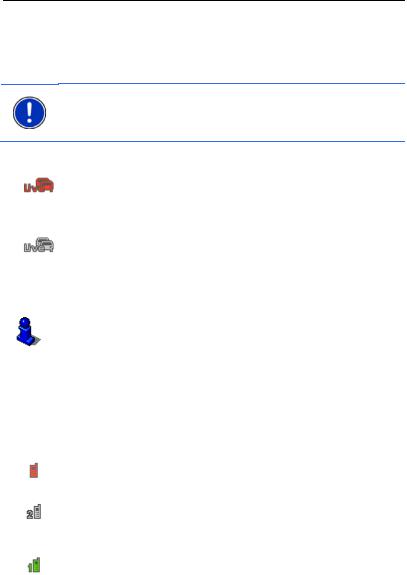
User’s manual NAVIGON Plus 70/71 | Premium 70/71 | Premium 70/71 LIVE
You can draw traffic information either from the NAVIGON Live services (Traffic Live) or from radio stations (TMC). (Refer to "Configuring the NAVIGON Live services" on page 113.)
The Traffic Live symbol appears when you are drawing traffic information from the NAVIGON Live service.
Note: This function is useful above all when TMC traffic messages are being transmitted in the country in which you are travelling and there are many vehicles using the service. This may not be the case everywhere.
The Traffic Live symbol can indicate the following traffic information reception states:
(Red) Connecting: The last attempt to call up traffic information from the NAVIGON Live server failed. This can be the case, for example, when travelling through a tunnel. Information which was called up previously may still be active however.
(Light grey) Traffic Live Ready: Traffic information was called up successfully. The active information is up to date.
Bluetooth / Phone
This section is relevant for you only if your navigation device is one of the following devices:
►NAVIGON Premium 70/71
►NAVIGON Premium 70/71 LIVE
The navigation device has an integrated Bluetooth hands-free module. This enables you to use the device as a hands-free kit for up to two mobile phones with Bluetooth capability.
The Phone symbol can display the following states of the hands-free module:
No Bluetooth (No symbol): The Bluetooth function is deactivated.
Not connected (red mobile phone): The navigation device has no Bluetooth connection to another device.
Connected (white mobile phone): The navigation device is connected to a mobile phone and can be used as a hands-free car kit. The number indicates which of the two phones is currently active.
Call in Progress (green mobile phone): The hands-free module of the navigation device is being used for a phone call. The number indicates which of the two phones is being used to make the call.
- 22 - |
Operating the navigation system |

User’s manual NAVIGON Plus 70/71 | Premium 70/71 | Premium 70/71 LIVE
Headset: A headset is connected. All the instructions given by the navigation system are heard over the headset. The telephone functions of the hands-free module are not available.
Muting
The Muting symbol can indicate the following states: No symbol: The navigation application is not muted.
Muting: The navigation application is muted. If the device is navigating at the moment, you will not hear any driving instructions.
Note: This icon indicates only the muted state of the navigation instructions. It says nothing about the volume of the hands-free module.
4.2Software keyboard
A software keyboard appears on the screen when text entries are necessary.
All entries can be made on the software keyboard using your fingertips. Only capital letters can be entered.
When entering town or street names you need not enter any special characters or umlauts. The navigation system fills in these characters for you automatically. For example, if you are looking for the town of "Bärnau", then simply type in the word "BARNAU". Special characters may be helpful however when naming saved destinations and routes.
4.2.1Special keys
 inserts a space.
inserts a space.
 deletes the character in front of the cursor.
deletes the character in front of the cursor.
 opens the keyboard with numerals.
opens the keyboard with numerals.
Latin, Cyrillic and Greek alphabet
 opens the keyboard with the Latin alphabet.
opens the keyboard with the Latin alphabet.
Note: The layout for the keyboard with the Latin alphabet can be configured.
►In the NAVIGATION window tap on Options > Settings > General > Keypad layout (Latin Alphabet).
►Select the layout you want to use (QWERTZ, QWERTY, ABCDEF, AZERTY).
Operating the navigation system |
- 23 - |
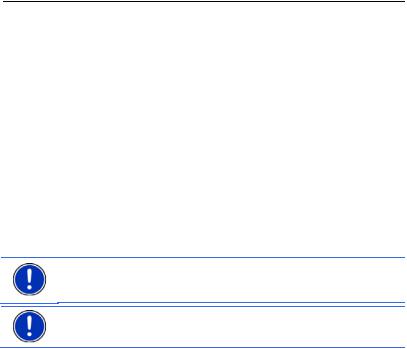
User’s manual NAVIGON Plus 70/71 | Premium 70/71 | Premium 70/71 LIVE
 opens the keyboard with the Cyrillic alphabet.
opens the keyboard with the Cyrillic alphabet.
 opens the keyboard with the Greek alphabet.
opens the keyboard with the Greek alphabet.
When you want to enter addresses, names or POIs, the keyboard with the alphabet for the country in question will open automatically.
When you want to save a destination to Favourites or when you enter a POI category or a country, the keyboard with the alphabet of the user interface will open automatically.
You can also switch from the Cyrillic or Greek keyboard to the Latin keyboard. Many addresses can then also be entered as transliterations or in the language of the user interface.
Example: The language of the user interface is English. You want to navigate to Moscow. You have the following options:
►"Москва" (Cyrillic)
►"Moskva" (transliterated)
►"Moscow" (English).
Note: Street names and place names can be entered only in the language of the user interface if that is how they exist in the map's database.
Note: The maximum number of keyboards is always 2.
Umlauts, accents and other letters
Another keyboard with special characters is available for each alphabet.  opens the keyboard with Latin special characters.
opens the keyboard with Latin special characters.
 opens the keyboard with Cyrillic special characters.
opens the keyboard with Cyrillic special characters.
 opens the keyboard with Greek special characters.
opens the keyboard with Greek special characters.
As soon as you have entered a special character the letter keyboard reappears.
4.2.2Entering data
Often you can select an entry from a list. This is the case, for example, when you enter a location.
As soon as you enter the first letter, the largest city in the given country that begins with this letter appears.
Enter more letters and after each entry the first city which begins with these letters will appear.
- 24 - |
Operating the navigation system |

User’s manual NAVIGON Plus 70/71 | Premium 70/71 | Premium 70/71 LIVE
►When the correct location appears, tap on  (OK) in order to complete the entry.
(OK) in order to complete the entry.
You can open at any time a list containing all the locations which begin with the letters or include the text already entered. The more letters you enter, the shorter the list becomes.
►Tap on  (Open List) in order to call up this list.
(Open List) in order to call up this list.
You can use the  (Up) button and the
(Up) button and the  (Down) button to move through the list.
(Down) button to move through the list.
►Tap on an entry in the list to select it and transfer it to the input box.
The list closes once an entry has been selected. You are now finished with entering the city.
►Tap on  (Close List) in order to close the list without selecting an entry.
(Close List) in order to close the list without selecting an entry.
Note: The list opens automatically as soon as it contains only 4 or less entries.
4.3Options
Some windows offer options that lead to more functions.
A description of all available options can be found in the chapter "Options" on page 51.
4.4Menus
Some buttons have menus which open when activated.
►Tap on a menu point to execute its function.
If you would like to quit the options list without selecting a function, tap on the button you used to open the menu.
5 Voice Command
This section is relevant for you only if your navigation device is one of the following devices:
NAVIGON Premium 70/71 NAVIGON Premium 70/71 LIVE
Voice Command |
- 25 - |
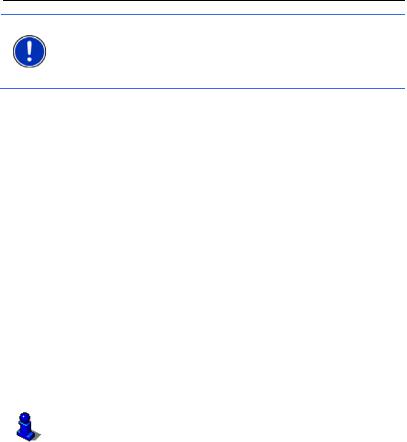
User’s manual NAVIGON Plus 70/71 | Premium 70/71 | Premium 70/71 LIVE
Note: The Voice Command function is not available in every language.
For languages in which this function is available, the Voice Command button is shown in the NAVIGATION window. For languages which are not supported, the Voice Command button is replaced by the Show Map button.
Many functions of your navigation device can be called up conveniently by voice command.
5.1Activating the voice commands function
The voice commands function is automatically active in many windows. This applies in particular to windows in which you are expected to provide an answer, for example when there is a new traffic message concerning your route.
Proximity sensor active:
If the proximity sensor is active, you can also activate the voice command function in the NAVIGATION window, in the map and in the HANDSFREE MODULE window as follows:
►Touch the frame of the navigation device.
As soon as you take your hand away again you will hear a single prompt tone and you can utter your command.
Proximity sensor inactive:
On the map in Standard or Navigation mode, the Voice Command function will be activated as soon as the button bar is shown:
►Tap on any point on the map.
You will hear a single acknowledgement tone and you can utter your command.
For more information on the proximity sensor refer to "Proximity sensor", page 57.
5.2Use Voice Command
When the functions in a window can be called up by voice command, this is indicated in the top left corner of the window by the symbol
 (Voice command active).
(Voice command active).
A single signal tone and the symbol  (Speak) indicate that the navigation system is waiting for your voice command.
(Speak) indicate that the navigation system is waiting for your voice command.
►Say a command.
The positive acknowledgement tone sounds (two high-pitch tones) and the function is executed.
- 26 - |
Voice Command |
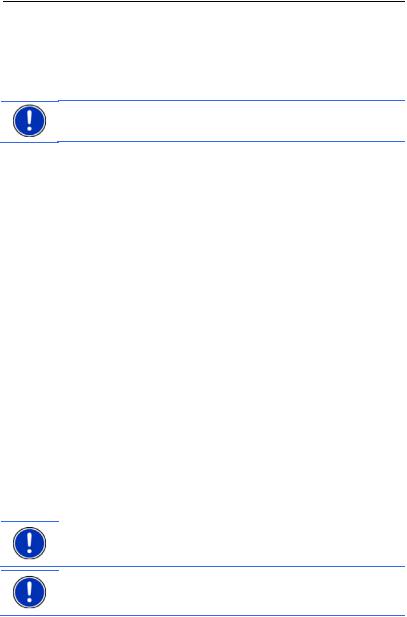
User’s manual NAVIGON Plus 70/71 | Premium 70/71 | Premium 70/71 LIVE
If the navigation system has not understood your instruction or if you do not say anything within a certain time, the negative acknowledgement tone (two short low-pitch tones) will sound.
►Say the command again.
If the navigation system has not understood you after several repetitions, the prompt "Say Help" will appear.
Note: Navigation instructions and warnings are muted for as long as the navigation device expects to receive voice commands from you.
5.3Help
Say only "Help" if you want to know which voice commands are currently possible. In nearly all windows in which voice commands are supported the navigation system will then tell you which commands you can say in the current window.
5.4Deactivation of the voice commands function
The voice commands function will be deactivated under the following conditions:
►If you operate the navigation device with your finger while a voice command is expected from you.
►If a call is received and during an active phone call if the navigation device is being used as a hands-free module.
5.5Configuring the voice commands function
You can configure for which tasks you want to use voice commands.
►In the NAVIGATION window tap on Options > Settings > General > Use Voice Command.
Select the tasks for which you want to use Voice Command:
►Complete: You can use all the voice command functions.
►Answering: You can enter addresses and answer questions asked by the navigation device.
►Entering Addresses: You can enter only addresses with the voice command function.
Note: For details of how to enter a destination using voice commands refer to the chapter "Entering a destination by voice commands" on page 30.
Note: For details of how to make a call using voice commands refer to the chapter "Making a call with the voice commands function" on page 102.
Voice Command |
- 27 - |
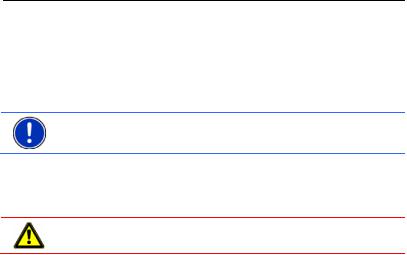
User’s manual NAVIGON Plus 70/71 | Premium 70/71 | Premium 70/71 LIVE
The volume of the voice controls assistant can be controlled independently of the volume of the navigation instructions. This means you can still hear the speak prompts when you have muted the navigation instructions.
1.In the NAVIGATION window tap on Options > Settings > General > Volume of the Assistant.
2.Select the volume for the assistant.
Note: For details of how to configure the navigation system refer to the chapter "Configuring the navigation system" on page 115.
6 Navigation
Use the navigation system at your own risk.
Caution! Be sure to refer to all the safety information in chapter "Important safety information" on page 10.
Impaired GPS reception
If GPS reception is impaired, navigation will be interrupted. As soon as GPS reception is restored, the navigation system calculates any change of position which has occurred in the meantime. Navigation is then continued automatically.
Arriving at your destination
When you have reached your selected destination, a message to this effect will be displayed.
Only your current position (orange arrow) and the destination flag will now be shown on the map.
6.1Starting the navigation application
You have switched on the navigation device. The following message appears:
"Please note that the road traffic regulations are prior to the instructions of the navigation system. Please do not operate the device while driving."
►After you have read and fully understood the message, tap on OK.
If you do not accept the content of the message, tap on Cancel in order to exit the navigation application.
- 28 - |
Navigation |
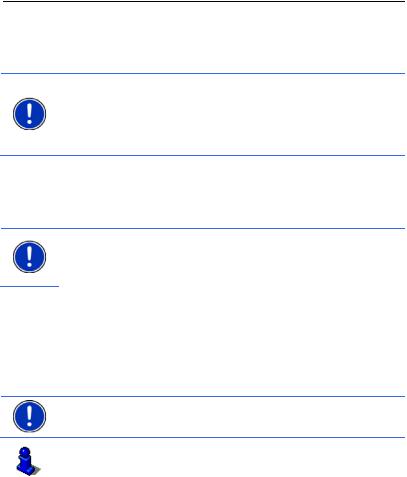
User’s manual NAVIGON Plus 70/71 | Premium 70/71 | Premium 70/71 LIVE
The NAVIGATION window is opened. From here you can access all the functions of the navigation application.
Initialising the GPS receiver
Note: Good reception of GPS data requires an unobstructed path from the GPS receiver to the satellites. Tunnels, narrow thoroughfares between buildings and reflecting house fronts can restrict GPS reception greatly or make it impossible. If the GPS receiver or the navigation device is inside a vehicle, a metallised windscreen or a windscreen heater can be the cause of poor GPS reception.
As soon as the navigation device has been switched on, initialisation of the GPS receiver will begin.
The integrated GPS receiver is not initialised for the first time until the navigation application is started for the first time. It can take up to
20 minutes to initialise the GPS receiver for the first time.
Note: If the GPS symbol indicates GPS Ready after far less than
20 minutes, it is advisable to leave the navigation device switched on for at least another 15 minutes in order to ensure reliable operation of the receiver.
Each time you switch on the navigation device after this, GPS reception will start within a short time.
If the navigation device has not been switched on for more than a week, it can take up to 10 minutes to re-initialise the receiver.
In the top right hand corner of the screen you will see the GPS symbol. As soon as data from at least three satellites is received, the symbol will
change to  (GPS Ready).
(GPS Ready).
Note: Initialisation takes the least time if you do not start driving until the initialisation has finished.
For more details about the GPS symbol refer to chapter "GPS" on page 19.
Returning to the Navigation window
The NAVIGATION window opens when the navigation application is started.
If another window of the navigation application is open, tap on  (Back). This will return you to the window you came from.
(Back). This will return you to the window you came from.
►Tap on  (Back) repeatedly until the NAVIGATION window is opened.
(Back) repeatedly until the NAVIGATION window is opened.
Navigation |
- 29 - |
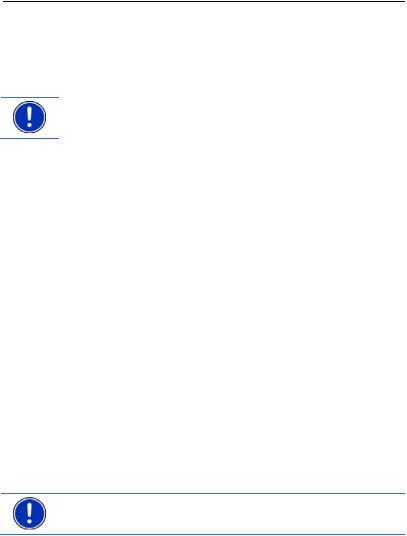
User’s manual NAVIGON Plus 70/71 | Premium 70/71 | Premium 70/71 LIVE
6.2Specifying a destination
Under New Destination you can enter destinations to which you have not yet navigated or which you have not saved.
Here you can enter the destination's address or coordinates, select a POI, or select a destination with the Direct Access function.
Note: The first time that you want to enter a new destination you will be asked to select the country in which your destination is situated.
Under My Destinations you can select from the following lists of destinations and addresses:
►FAVOURITES: All destinations that you have entered and then saved. Three special destinations are also saved in the FAVOURITES list:
►My Address: The address which was saved as the home address (refer to "Defining the home address" on page 45).
►My Vehicle: The location of your vehicle is automatically saved when you use the Parking Close to Destination function (refer to "Parking near the destination" on page 77).
►My Starting Point: The starting point of the last navigation is automatically saved.
►LAST DESTINATIONS: Destinations to which you have navigated on a previous occasion.
►IMPORTED ADDRESSES: All destinations that you have imported from Microsoft Outlook or from other data sources.
6.2.1Specifying the country in which the destination is situated
At top left in the ADDRESS, POI IN A CITY and POI NATIONWIDE windows you will find the Country button. It bears the flag of the country in which you can currently select destinations for the navigation application.
If your destination is in a different country, then proceed as follows:
1.Tap on the Country button.
2.Enter the name of the country in which your destination is situated. The button shows the flag of the destination country.
Note: The selection list contains only those countries whose maps are available to the navigation device.
6.2.2Entering a destination by voice commands
It is particularly convenient to select the destination by voice commands.
1. In the NAVIGATION window tap on Voice Command.
- 30 - |
Navigation |
